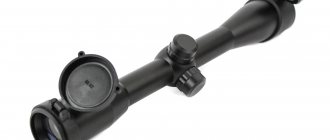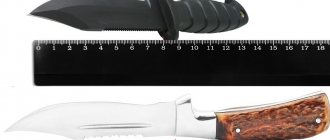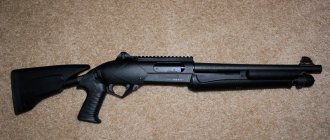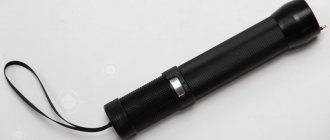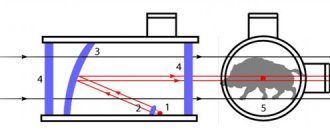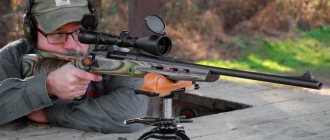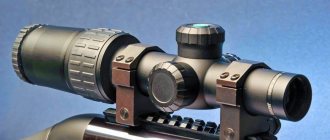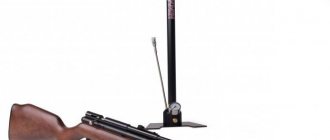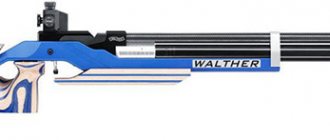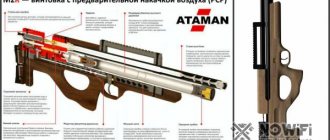A collimator sight for pneumatics is considered the best solution for shooting at moving targets under any lighting conditions. Since in this case aiming is carried out with two eyes, the shooter’s field of view is not limited in any way. Since most models do not provide the ability to approach, CPs are most often used to hit targets at close range. Structurally, the collimator sight is represented by a long-focus lens with an illuminated aiming mark installed in it. It is visible only to the shooter, which is very convenient when shooting from cover.
Vortex Sparc AR
A well-deserved place in the ranking of the best red dot sights is occupied by the Sparc AR device from the Japanese brand Vortex. Fits AR-15 model weapons.
Main characteristics:
- closed;
- 74 mm (length);
- 213 g (weight);
- Weaver mount;
- 2 MOA dot (reticle type);
- 22 mm (lens diameter);
- 1 AAA battery (power);
- 1x (multiplicity);
- $250 (price).
Pros:
- backlight;
- backlight adjustment;
- wide range of corrections.
Minuses:
- not used with VMX-3T Magnifer;
- only at close distances;
- no thermal imager properties;
- does not increase.
The best sights for air rifles
If you've jumped to conclusions, we still highly recommend reading the article before choosing a scope from our ratings below. A mismatch between the scope and the type of rifle you have can lead to the results shown in the first picture in the article...
Manufacturers of optical sights for pneumatics
Almost all manufacturers of sights have lines for the most common air guns. But, for example, Hawke, initially specialized in pneumatics.
Currently, the market is flooded with Chinese counterfeits of famous brands. The most commonly counterfeit scopes are Leupold, Nikon and Zeiss. Moreover, not only sellers from Avito or Aliexpress, but also well-known domestic stores do not hesitate to pass off fakes as originals. In general, the quality of the optics of the fakes is not bad, but you should not expect the accuracy of the mechanical elements: uniform pitch of clicks and clicks for entering corrections, smooth rotation of the eyepiece and changes in focus, tightness; as well as Mil-Dot marking pitch.
At the same time, inexpensive Chinese sights are sufficient for most entertainment and training purposes. In this case, pay attention to sights that have warranty and service centers in Russia. Below are models of some of these brands (Veber, Combat, Sturman, Target Optic). However, pay attention to the compatibility of the airgun's recoil energy with the recommendations for the scope.
Holosun Paralow
Collimator sight from the Chinese brand Holosun. The compact device (with a red dot) is installed on hunting rifles, pistols, and air rifles.
Description:
- closed;
- 6.3 cm;
- 124 grams;
- 22 mm lens;
- 2MOA dot;
- 1x magnification;
- CR2032 battery;
- Picatinny (Weaver);
- 300 dollars.
Advantages:
- NVD compatible;
- backlight;
- 10 brightness levels.
Flaws:
- does not serve to increase;
- cannot see an object in complete darkness;
- only for close aiming.
Marcool ACOG 1X40
The ACOG 1X40 model from the Chinese company Marcool takes a well-deserved place in the list of the best budget red dot sights for playing airsoft. The device is not used for hunting.
Peculiarities:
- closed;
- 42 mm;
- 90 grams;
- lithium CR1620;
- RIS-bar;
- $75 (price).
Pros:
- red or green reticle;
- 5 brightness modes.
Minuses:
- not installed on hunting rifles (will not withstand severe recoil);
- only for playing airsoft.
How to zero an optical sight on a pneumatic rifle
Bringing PCP, multi-compression and CO2-powered pneumatics to normal combat is done using a special machine, from a table or from a rest. It is not much different from zeroing a conventional firearm, but taking into account ballistics: short range of a direct shot, low bullet speed and high flatness of the trajectory.
The peculiarity of spring-piston pneumatics, which is often used for entertainment, is that it is better to shoot it by hand, according to the specific shooter and his grip. This is related to the design of the weapon, but is not as complicated as it might seem at first glance. Here is a detailed guide for beginners.
We are often asked the question - why doesn’t the scope zero? In this case, they name a model that is either not intended for installation on pneumatic rifles and does not maintain the center zero point (STP), or the name of the sight can only be found on the Chinese Internet. We can only sympathize; it’s a pity that you didn’t come across this article earlier.
Patriot 1x22x33
Collimator sight from the Chinese company Patriot. Suitable for hunting rifles (up to 12 gauge) and shooting at stationary and moving targets.
Main characteristics:
- panoramic (open);
- 81 x 38 x 54 mm;
- 120 grams;
- 22 x 33 mm (lenses);
- 34 m (field of view at 100 meters);
- “dovetail” (fastening);
- sighting reticle with 4 brand options;
- $50 (cost).
Advantages:
- backlight;
- brightness adjustment.
Flaws:
- for close aiming;
- cannot see the target in complete darkness;
- performance is reduced in unfavorable weather conditions.
Night sight
A special type of sighting device used for shooting in low light conditions. This category of sights is divided into two types: new (digital) and old generation. And although the figure has many undeniable advantages, it is very expensive, so for the owner of a pneumatic it would be better to choose something from the budget category.
If finances do not play a big role for you, then it would be useful to familiarize yourself with the advantages of new generation night vision devices:
- Immune to recoil. The digital “body kit” is able to withstand inertia even when using a firearm, and it will not feel the recoil of a percussion-piston rifle at all.
- Ability to change the type of digital grid. Mil-Dot sighting brand, which is considered the best for air guns, is available in stock.
- The ability to create sighting profiles is useful for shooting at different distances.
- Digital zoom. Its main feature is that along with the image scale, the grid also increases.
- Frame-in-frame mode provides accurate and fast aiming.
- High image quality at a distance of 100 meters (the distance at which IR illumination works).
- The ability to use the sight during the day (just turn off the illumination mode) is useful for training shooting.
The most expensive night vision devices, for example, the Pulsar Digisight Ultra N455 model, are equipped with built-in laser rangefinders - they show the distance to the target. This is an incredibly handy thing for making quick adjustments. Using such a sight, it will not be difficult to get into the animal’s weak spot, even if it is at a distance of 100 meters.
Among budget NVD models, the Phonton RT 4.6×42 brand is in greatest demand. Although the body kit does not have a laser rangefinder, and cannot be used in extreme cold (-15 degrees Celsius), it will not cost a fortune.
ZENIT PKM 125 without fastening
Inexpensive Russian sight. Used for hunting rifles model IZH-58 (16 gauge) and carbines “Tiger”, “Saiga”, “Vepr” and “Los-7”. Suitable for shooting at standing and moving objects.
Description:
- closed;
- 25mm lens;
- 1x magnification;
- 3 types of reticle (4MOA, stump, stump with dot);
- 112 x 56 x 68 mm;
- 300 g;
- element SR 2430;
- 80 dollars.
Pros:
- brand adjustment;
- precise alignment mechanism;
- backlight
Minuses:
- weak increase;
- cannot see the target in complete darkness;
- mechanical adjustment (no automatic).
VOMZ AVIS PC 1x20 military
The Russian 1x20 Avis collimator sight is designed for medium-caliber hunting rifles. Used for aiming at stationary and moving targets. Works in any lighting (daytime and twilight). Does not have the properties of a thermal imager (does not see an object in the dark).
Description:
- closed;
- 6.7 cm;
- 196 grams;
- 20 mm lens;
- 1x (multiplicity);
- Picatinny (Weaver);
- 2MOA dot;
- $150 (cost).
Advantages:
- red backlight;
- withstands shock loads of 800 g;
- backlight adjustment.
Flaws:
- only at close range;
- no thermal imager properties;
- no magnification.
VOMZ PK-R
The collimator of the Russian manufacturer VOMZ is designed for aiming at various targets, including fast moving ones. Installed on sporting and hunting rifles of medium caliber.
Main characteristics of the sight:
- open;
- 30mm lens;
- 86 x 49 x 40 mm;
- 0.15 kg;
- 4MOA dot;
- dovetail mount;
- battery CR2032;
- 102 dollars.
Pros:
- 3 types of reticle;
- withstands 800 g shock load;
- adjusting the brightness of the glow.
Minuses:
- It is undesirable to use in adverse weather conditions;
- weak 1x magnification;
- not suitable for long-distance tracking.
Recommendations for choosing optics depending on the type of weapon
Besides magnification, reticle type, lens diameter, and personal taste, there are a few practical guidelines that you can use when choosing a scope depending on the type of weapon.
Spring-piston air rifles
The peculiarity of spring-piston pneumatics is that the recoil acts in both directions: in the direction of the bullet’s flight and in the opposite direction. The cheapest scopes from Aliexpress often “fly out” after the first shot (in the first photo of the article there is just one).
For Russian-made spring-piston rifles of the MP-512, MP-60 and MP-61 models, it makes sense to choose the most inexpensive sights with a constant magnification of 4-6x. Accuracy and reliability are enough for training and fun, and nothing more is required from an entry-level weapon. Specific models that we can recommend are Veber Black Fox 6×40 AO MD, Combat 4×32.
Of the entry-level variables, we can recommend the Veber 3-7×20 with the caveat that its “native” mounts are installed very low, and others will not fit due to the non-standard tube diameter. For the MP-60 with vertical loading of bullets, reloading with such a sight will become difficult! Therefore, the best option would be Veber 3-9×40 CBR with a more universal pipe with a mounting diameter for rings of 25.5 mm.
Separately, it is worth highlighting the sights of Chinese origin. We suggest considering the brands Sturman and Target Optic, since these sights have a guarantee, unlike “noname” models and orders directly from Aliexpress. These are worthy options for novice shooters, which, at their cost, have more interesting reticles, including in the first focal plane, or minimal sizes with a wide range of rays (the so-called “minis”) for installation on compact PCP rifles.
Don’t forget to buy additional rings for the dovetail sight - these are exactly what are needed for Russian air guns. They are inexpensive, but it is better to do this right away, because most sights do not come with mounts.
Separately, it is worth highlighting two whole series of pneumatic sights Mountmaster and Airking from Nikko Stirling, the peculiarity of which is associated with a wide choice of magnification and the presence of a Dovetail mount in the kit.
Here we remind you once again that despite the low muzzle energy of the bullet, spring-piston rifles have bi-directional recoil, which is non-standard for most sights. Cheap Chinese sights either literally fall apart or do not hold the reticle: after a few shots the weapon will have to be sighted again. Among inexpensive scopes, choose those that explicitly indicate the possibility of use with piston pneumatics. Taking into account the price segment, in our catalog we have selected only models of sights from Chinese manufacturers that are compatible with pneumatics and provide warranties in Russia.
Check the permissible muzzle energy, for example, when installing a more powerful spring, and more on this later.
Magnum class pneumatics
Owners of magnum class rifles, such as Hatsan Striker Edge, Hatsan 125 Magnum, Gamo, Crossman, Diana and the like, can pay attention to inexpensive products that can withstand double recoil. Models with constant magnification 4-6X of the Vologda optical-mechanical (Pilad 4x32 Pnevmo model with various reticles) and sights from Veber from St. Petersburg are the best in this class in terms of price/quality ratio.
However, Magnum pneumatics allow you to develop high-precision shooting skills, and if your budget allows, it makes sense to choose a sight from higher-class manufacturers, such as the Hawke Airmax series.
Pre-pumped (PCP) rifles
PCP rifles have virtually no recoil, which has a destructive effect on the sight, and the accuracy of the shot is much higher than that of other types of pneumatics. For such weapons, optics with variable magnification of 4-12 or even more powerful are best suited.
If you have a limited budget or need a lighter scope, we recommend choosing one with constant magnification. It's not as comfortable, but it's much better than cheap zoom models. The fact is that most of them have a reticle in the second focal plane. Its dimensions remain constant when the scale changes. On such a scale it is more difficult to introduce corrections.
Recommended models of sights: Hawke Sidewinder 6-24x56 (FFР Мil) with a reticle in the first focal plane, Hawke Sidewinder Tactical SF 10x42 constant magnification, Hawke Vantage IR 3-9x40 AO IR with a reticle in the second focal plane, 8x48 Pilade constant magnification.
Aimpoint Micro H-2
The Swedish collimator is installed on semi-automatic hunting rifles.
Thanks to the reinforced housing, the device can withstand the heaviest calibers. Suitable for aiming at stationary and moving targets.
Description of the collimator sight:
- closed;
- 6.2 cm (length);
- 235 grams;
- 2MOA dot;
- red stamp;
- CR2032 battery;
- mounting bracket;
- $659.
Advantages:
- 12 backlight levels;
- ASET energy saving technology (50 thousand hours).
Flaws:
- does not increase (1x);
- for close range only;
- does not have the properties of a thermal imager;
- not compatible with night vision devices.
Recommendations
Before purchasing a guidance device, it is important to evaluate the reliability of the mounts, technical capabilities, and what type of bar it is installed on. The presence of a durable, sealed case does not mean that the gearbox cannot be damaged. Lenses are the “weak link”; they are subject to external negative influences: scratches, cracks may appear, and aiming may become difficult.
Cleaning and maintenance of collimators is carried out using special means and materials. Wiping dust from lenses with a regular cloth can damage the sensitive surface of the glass. The battery is inserted into the device before use and removed after - this tip will keep the power contacts in working condition.
A collimator sight mounted on a pneumatic gun is easily damaged during transportation. It is recommended to remove the device from the weapon and carry it (transport it) in a case.
A collimator sight mounted on a pneumatic gun is easily damaged during transportation.
It is recommended to remove the device from the weapon and carry it (transport it) in a case. October 19, 2022
Bering Optics Precision Reflex
The Precision Reflex collimator is installed on sporting and hunting rifles. Suitable for aiming at stationary and moving targets. Withstands slight recoil.
Description of the collimator sight:
- closed;
- 11.6 cm long;
- 310 grams;
- 30mm lens;
- 4MOA dot;
- laser 3A;
- Weaver;
- designed for output up to 500G;
- CR2032;
- $148.
Pros:
- three-color mark;
- laser laser center;
- can illuminate an object in complete darkness;
- 3 brightness modes.
Minuses:
- no magnification;
- for close aiming;
- for light firearms only.
Features of the red dot sight
A feature of many red dot sights are open optical parts - lenses and mirrors. In the case of closed structures with a durable tubular body, the risk of damage is minimal. The difference between open sights containing a lens in a small frame is the high probability of damage to the sight due to external mechanical influence.
Collimators must be used carefully, despite manufacturers' assurances about the high strength of their products. Although quality scopes can withstand significant abuse, you should avoid knocking them or dropping them on the ground. To use the collimator as efficiently as possible, you will have to spend time fixing it correctly and zeroing it.
Holosun Micro Elite
The Chinese red dot sight is installed on shotguns, pistols and air rifles. Works during the day and at dusk, compatible with night optics.
Description of the collimator sight:
- closed;
- active;
- 6.2 cm;
- 121 grams;
- 20 mm lens;
- 2MOA mark;
- green LED;
- Picatinny (Weaver);
- retractable battery compartment;
- CR2032;
- $390.
Advantages:
- NVD compatible;
- adjustable brightness (12 levels);
- memory function;
- sleep mode (energy saving).
Flaws:
- does not increase;
- does not have the properties of a thermal imager;
- only for close range.
Laser target designators (LTD).
Laser target designators (LTCs) - or, as they are often called, laser sights, create a laser beam. The axis of the sight (laser beam) must be parallel to the axis of the weapon barrel. Aiming is carried out by pointing the laser beam at the target. The sight is convenient at short distances and allows you to aim from any position without looking at the weapon. However, when shooting at small targets, it is worth considering that the axis of the beam is slightly offset relative to the axis of the barrel and make adjustments. In relation to pneumatic weapons, LCCs are loved mainly by pistol owners, which is justified by pistol distances. Many air pistols and some rifles have a laser sight mount under the barrel near the muzzle.
On military small arms, laser target designators with a visible spectrum beam are not used, as they give away the location of the shooter. They are replaced with sights with a beam of light spectrum invisible to the naked eye, and the weapon is equipped with special optics through which the shooter can see the beam mark. The exception is assault groups that conduct short-term close combat; for them, a visible laser beam is preferable.
pros
– ease of aiming, mainly at static targets. Shoot from any position without looking at the weapon. Long-term training does not tire the eyes. Ease of use on the pistol.
Minuses
– gets clogged easily. Gives the position of the shooter. It makes no sense to use it at long distances without additional sighting devices.
Optics for air guns.
An optical sight is an irreplaceable thing if the target is at a sufficiently large distance from the shooter’s location. An air gun without optics is just a gun with which to guard a vegetable warehouse at the right time. As for such a thing as a high-quality air gun, it is worth noting that an optical sight will not only decorate your weapon, but will also add one very wonderful function to it : Now you don’t have to squint in an attempt to see a distant target - the optics will work in such a way that your target will be in full view, just reach out and touch. Fortunately, you can only touch the target with a bullet, but with a pneumatic rifle equipped with an optical sight on hand, you can be one hundred percent sure that you will be able to touch the target after the first shot. Just remember that weapons of this category are intended for purely peaceful purposes, and not for hunting, even not for sparrows, so follow the rules for using this weapon and use it for its intended purpose only in extreme cases. Just notice what an advantage you have with the purchase of an optical sight for your rifle - you may even feel like a real sniper in the wilds of the Amazon, but I repeat, I would not advise you to get carried away with this beautiful game. The advantage of an optical sight is, first of all, that it is much easier to aim even at a small target than to do the same thing with a target sight. Of course, if you are a professional and your hand is trained, you can hit the target without optics, but it is much easier and more likely to hit the same target, but already knowing that you will not miss. By the way, having bought an optical sight, take care to adjust it as accurately as possible, because the accuracy of shooting in the future will depend on this. Before purchasing an optical sight, you should pay attention to small details, as well as the optical glass itself - there should fundamentally be no cracks, chips or other cloudings on the most important part of the optical sight. Pay also attention to the manufacturer; If the company is familiar to you and you have already used its services, it is better to use it, which has been proven. It should be borne in mind that domestic manufacturers are in no way inferior to foreign ones in terms of the quality of the products they put on the market, so you should not neglect brands such as Anix or, for example, Izhevsk. All models of optical sights have a warranty period, so if you buy an air gun, I advise you to also take a closer look at the optics. The optical sight itself is not only multifunctional, but also easy to use. You can set it up either yourself or with the help of a professional. Usually in stores there are instructions for high-quality shooting of optics, so you shouldn’t have any problems with this matter initially. You should also pay attention to the mounts for the optical sight to your pneumatic weapon, since, for example, it is better not to take a Chinese mount - there are pneumatics with fairly dense recoil, as a result of which all these mounts may very soon be written off. Remember that if you take an optical sight from a certain brand, you should make sure that the mount for the optics is from the same company as the weapon, as well as the sight itself. With the purchase of an optical sight, you will understand what a big difference there is between a front sight and such an optical modification, and shooting will seem like a fairy tale to you. At this time, there is a huge selection of optics suitable specifically for use in airguns, so there will always be something to choose from, and manufacturers proven in the sales market for these products will once again prove their professionalism.
Collimator sight
A collimator sight is one of the best types of sighting devices suitable for air guns. It allows you to significantly simplify the aiming process and speed it up by 2 to 3 times. A collimator sight, unlike mechanical adjustment of the stock, does not require vision training and repeated aiming procedures. Here it is enough to combine the target and the mark. Therefore, even inexperienced pneumatic fans can use it. This ease of operation is explained by the design features of the collimator sight. It consists of a lens, an illuminator and a luminous aiming mark installed at its focus. The lens is a lens with a beam splitter coating, which is installed at a certain angle to the sight line. The rays from the LED illuminate the aiming mark, are reflected from the surface of the concave lens and are focused, forming an image of the aiming mark at a remote distance, which is combined with the target. The collimator sight allows you to aim using both eyes. Thus, the shooter can see the target, the reticle, and the surrounding space at the same time. This is a great advantage since the shooter can shoot before the target enters the sighting field. However, the single-use nature of these scopes makes their use limited. They are used only for straight-line shooting.
Collimator sights for air guns come in open and closed types.
In a red dot sight, the lens in a thin frame is located at a slight angle to the sight line.
This can be either a glass plate or a lens, which has a reflective coating on one side and a transparent coating on the other. The collimator itself is located at the base of the sight. All this allows you to see two images simultaneously in the sight field: the target and the reticle. The lightweight, open design allows the shooter to have a wide field of view around the target, which is an advantage when shooting with an air pistol or rifle. The disadvantage of this design is the low level of protection of the sight from negative mechanical and atmospheric influences. A closed-type collimator sight is a symbiosis of an optical sight and a collimator. Its appearance is very similar to the optical sight, but shorter. It is mounted on pneumatic rifles using brackets for optical sights. Since the design is closed, the aiming mark is adjusted using a button or handwheel located on the body of the sight. The design of the closed body and the location of all collimation elements parallel to the aiming axis slightly limit the observation radius. However, this design reliably protects the sight from dirt, rain, snow or mechanical impact. The advantage of both types of red dot
sights is that they allow you to fire air guns in poor visibility conditions. The clarity of the sight is ensured by a luminous reticle, which can look like a dot, a solid crosshair or with a central break. To make the reticle more visible in the aiming field in poor lighting, it can blink and also change its brightness level. Depending on the model of the sight, the brightness of the reticle can be adjusted either automatically or using manual adjustment. In addition to the degree of brightness, the aiming mark can also change its size. However, its size should not be 0.25-1 times larger than the size of the target. A collimator sight is a sight in which the aiming mark is formed using an optical collimator. In a collimator sight, the prototype of the aiming mark is located at the focus of the optical element, which has positive optical power. In this case, the light flux passing through this element and carrying information about the aiming mark is recorded by the observer’s sighting eye. Attempts to make a sight that would combine the simplicity of an open mechanical sight and the ability to observe the aiming mark and the target in the same plane, which was provided by a telescopic sight, have been made for a long time. So, at the beginning of the 20th century, Russian naval officer A.I. Krylov invented the so-called “optical front sight” - the prototype of a modern collimator sight. The sight consisted of a front sight and half a collecting lens, cut along the optical axis. The front sight was located at the focus of the lens, which, in turn, was located between the front sight and the shooter's eye. Thus, the shooter saw the target and the front sight equally sharply, which made it possible to quickly take aim at various targets. However, due to some inconvenience that arises when using the sight, it is not widely used. During the Second World War, red dot sights were used as sights for bombing and artillery and small arms in aviation. Red dot sights have become widespread as sights for small arms since the early 1980s, when world advances in semiconductor technology made it possible to create high-quality LEDs with low current consumption and a large dynamic range of brightness. Collimator sights for small arms can be classified according to the presence of a sighting channel (if possible, to observe targets through the sight) into stereoscopic (without a sighting channel) and conventional (with a sighting channel). The stereoscopic red dot sight is not transparent. Aiming with its help is carried out with two open eyes, while using such an ability of human vision as stereoscopicity, that is, the ability to perceive as a single two images observed by the right and left eyes. In relation to red dot sights, one eye sees the image of the aiming mark, and the other the image of the target. The human brain perceives two images as one and creates a picture similar to that produced by a conventional (transparent) red dot sight. According to the possibility of pairing with weapons, red dot sights are divided into: - universal - installed using special brackets on various models of weapons; - specialized - made together with a bracket for installation on certain types of weapons; - integrated - built into the weapon. The operation of collimator sights is based on the use of the principle of light collimation, that is, obtaining a parallel beam of rays corresponding to distant objects of observation. The collimator is a long-focus lens in which the illumination mark is installed with a special device. It has the form of a pinhole or grid with the necessary service information. For collimator sights mounted on small arms, the mark is a diaphragm that forms a luminous aiming point.
The principle of operation of a red dot sight
Red dot sights come in closed and open types.
All elements of closed collimator sights are located along the optical axis of the line of sight and, when forming a point in space at which aiming is carried out, they slightly limit the observation area. The collimator of open red dot sights is removed from the shooter’s field of view and the formed aiming mark is projected onto the observed space. All red dot sights have single magnification and unlimited eye relief. True, a single magnification limits the use of such sights at a direct shot distance. The size of the luminous aiming dot in various sights ranges from one to fifteen arc minutes. There are sights with a variable aiming point, which is determined by the size of the target and the distance. Most currently produced red dot sights produce a red image of a luminous aiming dot. However, there are cases when the ratio of target and background colors makes the red dot barely visible, and sometimes completely invisible. Therefore, devices with green color are currently produced; there are also models with changing color - from red to green. The brightness of the luminous point is of great importance. On a clear sunny day it should be maximum. In cloudy weather and twilight, to avoid changes in eye adaptation and target illumination, the brightness must be reduced. The best models of red dot sights use a system that provides up to ten degrees of change in the brightness of the aiming point, and this change can be made automatically or manually. A further development of collimator sights is holographic, consisting of a flat transparent hologram, illuminated to create an image of the aiming mark with a laser beam. On the hologram, both traditional classical two-dimensional solid marks - a dot, crosshair, concentric circles, and so on - and a three-dimensional aiming mark, which is a line in space, which is a continuation of the barrel of a weapon and is aimed at target. The flat holographic screen of the sight can be replaced within thirty seconds with another one with a reticle suitable for the shooting conditions. The brightness of the reticle image is adjusted by changing the power of the illumination laser. The field of view of a holographic sight is unlimited, since only the frame of the holographic screen falls into it from the sight. The eye relief, like all red dot sights, is arbitrary. 06 June 2013
Holosun Open Reflex
The Chinese panoramic collimator allows you to aim with two eyes. Installed on hunting shotguns. The backlight is powered by two power sources - a solar battery and a regular disk battery.
Main characteristics of the collimator sight:
- open;
- 9.1 cm;
- 264 g;
- 32 x 24 mm (lens);
- 3 aiming marks;
- 2MOA;
- dual power supply - CR2032 + built-in solar battery;
- Picatinny (Weaver);
- $490.
Pros:
- NVD compatible;
- low energy consumption;
- adjustable brightness (12 levels);
- reticle illumination;
- memory saving function;
- sleep mode.
Minuses:
- no magnification;
- only for shooting at nearby objects;
- cannot see in the dark;
- Not recommended for use in adverse weather conditions.
Shooting step by step
It is important to choose the right place for shooting:
- without a pond;
- no wind;
- away from highways and railway tracks.
Even a projectile flying over puddles can affect the outcome of the shooting. The wind adjusts the bullet's flight path. It is worth paying attention to the ground: rising dust will clog the device.
The safety of others is also important. The shooting should be carried out in a ravine or lowland, then the bullets will get stuck in the soil. Or choose an open area to quickly determine the absence of people. The ideal solution is to go to a shooting range or training ground.
The position of the owner of the pneumatic is important. It makes no difference to a pro - he will quickly shoot the “air gun” while standing. Lack of experience will require shooting from a rest position, sitting or lying down. It is selected based on the type of pneumatic, for example, it is inconvenient to shoot a spring-piston sample while lying down due to the peculiarities of reloading. The shooter should not feel discomfort.
Clamping the rifle or pistol in a vice (special, not homemade) will help determine accuracy. Implementing an idea is not easy.
10 meters is the starting distance for zeroing the “aircraft” and the step. Gradually increasing the distance to the target, it is convenient for the shooter to adjust the collimator sight
It is better to use sports paper markings (targets) for better orientation at the time of shooting. The main thing is to choose the right size. If the procedure is carried out by an experienced shooter, the option with small rings is sufficient, and if “green” - large ones. For hitting a specific ring, the user receives up to 10 points - this is how the effectiveness of the air gun is assessed.
How to zero a reflex sight on a pneumatic rifle - follow 5 steps:
- Primary shooting.
It is required to point the weapon at the object to check the correct operation of the collimator sight. Task: check if the mark and target match. It is desirable that the object be dimensional, which will allow the most minor deviations to be detected. - Test shooting.
3-5 control “volleys” are played. - Detection of displacements between the aiming and impact points.
- Collimator adjustment.
Performed in accordance with the guidance device manufacturer's instructions. It is enough to turn 2 drums on the body. Objective: increase aiming accuracy. - Repeated shooting.
The shooter makes a series of new shots, trying to hit the central point of the target. Adjustment of the collimator sight on pneumatics is carried out if necessary.
Important.
5 shots are not always enough to zero in. There is no need to chase accuracy, always getting into the top ten. Task: shoot at a paper target until the accuracy improves.
After zeroing, it is wise to check the collimator mounting screws to see if they have come loose. If necessary, tighten them. You can also completely remove the guidance device from the bar and then reinstall it. The collimator settings should not be lost after manipulation.
Cold shooting – originality and speed
Cold zeroing will help reduce the time it takes to fully set up a rifle or pistol for battle. It is performed by a laser device with a body made of a polymer tube. It is built into the barrel and turns on. The laser will help determine the actual direction of the barrel. But, you need to take into account the quality of the bullets and how much their flight trajectory changes.
A weapon with an activated laser pointer is aimed at a target from a specific distance, while simultaneously adjusting the aiming mark. The method allows you to calculate the trajectory of the projectile and the actual deviation of the impact point (height).
SIGHTMARK SM13003B-DT 1 X 33-24, open
Collimator of American brand and Chinese production. Installed on sporting, hunting weapons and even .50 caliber rifles. Allows you to aim at stationary and moving objects. Suitable for offhand shooting.
Sight description:
- open;
- 33 x 24 mm lens;
- 8.2 cm;
- 119 grams;
- 4 types of reticle;
- 3MOA, 5MOA;
- dovetail;
- CR2032;
- red stamp;
- 130 dollars.
Advantages:
- sensitive correction mechanism;
- brightness control (7 levels).
Flaws:
- no magnification;
- for aiming at distances up to 35 meters;
- not compatible with NVGs;
- can't see in the dark.
Aperture (ring and diopter) sights.
Ring sights
- similar in design to open ones, but the rear sight is either a shield with a round hole (aperture) or a ring. The front sight is thin, often framed at the edges by a ring or half-ring for ease of aiming. When aiming, the shooter looks through the hole (aperture) in the rear sight, but without focusing on it. Unconsciously aligns the line of sight with respect to the light spot projected by the aperture onto the eye. The sight is adjusted like an open sight. The aiming line is longer than in an open sight, since the rear sight is located close to the eye, which in turn has a positive effect on accuracy. These sights are common on small arms of NATO countries.
Sometimes aperture sights can be found on domestic air weapons. An example is the Izhevsk rifle MP-514.
pros
– good visibility around the target visible through the sight (in an open sight, visibility from below is completely limited). High aiming speed compared to open sights. Better accuracy than with an open sight.
Minuses
– The rear sight limits visibility outside the aperture. Not applicable on pistols.
Diopter sights
- a type of aperture sight. In diopter sights, the hole in the rear sight is very small, the size of the pupil of the eye. Through this hole, the target is visible with great sharpness, which is why the sight got its name. The rear sight shield is quite large and completely blocks the view. Of all the mechanical sights, the diopter sight is the most accurate, but has a limited field of view and is not suitable for shooting at moving targets. Thanks to these qualities, it has mainly become widespread in sports bullet shooting.
pros
— accuracy of fire is the best of all mechanical sights.
Minuses
– narrow field of view through the sight. Lack of full view. Unsuitable for shooting at moving targets. Not applicable on pistols.
Sightmark Ultra Shot
Collimator for rifled and smooth-bore weapons of any caliber. Allows you to aim at stationary and running objects.
Characteristics of the collimator sight:
- open;
- 34x25 or 33x24 mm (lens);
- 9-11 cm;
- 170-303 g;
- red stamp (in some models additionally green);
- 4 types of aiming reticles;
- 3MOA, 5MOA, 10MOA;
- CR1620 or CR123A;
- Weaver/Picatinny;
- 200 dollars.
Pros:
- adjustable brightness;
- choice of aiming mark;
- reticle illumination.
Minuses:
- no magnification;
- for close aiming;
- no thermal imager properties.
Hakko BED-17-30
The Japanese collimator is installed on weapons of any caliber. Suitable for hunting and sport shooting.
Description:
- closed;
- 26mm lens;
- 13.8 cm;
- 137 grams;
- 4 types of aiming mark;
- 1MOA, 4MOA, 6MOA, 10MOA;
- CR2032;
- Weaver/Picatinny;
- $190 (price).
Advantages:
- brightness adjustment (11 positions);
- selection of the aiming mark.
Flaws:
- no magnification;
- cannot see in complete darkness;
- for close aiming.
Main characteristics of optical sights for pneumatics
Optical sights are perfectly compatible with all models of air rifles: spring-piston and multi-compression rifles, PCP (pre-pumped) and CO2-powered. This is probably the very first thing anyone buys to upgrade a new rifle. There are three main criteria for making the right choice:
- type of reticle;
- multiplicity;
- lens diameter.
Each of them, depending on the type of weapon and its features, has a different effect on shooting accuracy, convenience and reliability of the sight. The limitation, the same for any weapon, is due to the flatness of the bullet’s flight path. For all air rifles, the trajectory determines the effective range, which is short compared to firearms. And for precision optical sights it is important to take it into account. Let's look at this point in a little more detail.
Flatness of trajectory
The mass of the bullet and the initial velocity of pneumatic weapons are small, and the permissible energy of the most common unlicensed guns should not exceed 7.5 J. But even for enhanced pneumatics, a bullet accelerated to 250-270 m/s has a strongly descending trajectory after 50 meters.
Aimed shooting from a license-free air rifle (7.5 J) at a distance of over 50-70 meters is practically impossible.
This is clearly visible on the graph (caliber 4.5 mm, bullet weight 0.67 grams, speed 280 m/s), the aiming line is at a height of 7 cm from the barrel bore. As can be seen from the graph, the vertical deflection of the bullet is not critical, up to a distance of 50 meters. Further, the drop of the bullet is so great that it becomes almost impossible to take into account its drop without a rangefinder.
To build a similar graph for your weapon and ammunition, as well as calculate the influence of side wind on the impact point, you can use the free Hawke ChairGun application. You can download it for free in the apple app store and google play.
At the same time, an optical sight on an air rifle allows you to master methods for correcting the fall of bullets by making ballistic corrections. To do this, you need to know the exact distance to the target and the bullet's drop curve.
If you anticipate shooting where the distance to the target is not known in advance or at distances greater than 50 meters, we recommend purchasing one of the inexpensive laser rangefinders. Even the most budget model Veber 7x25 LR 400 determines a distance of up to 400 meters, which is enough for any air gun.
Best Reticle
Inexpensive reticle of the Combat 3-9×32 E sight for PCP and pneumatics up to 7.5 J
Unlike firearm sights, the reticle for air rifles must be thin. For beginners and shooting at a short, targeted distance, the “cross” type reticle, which is installed on most inexpensive pneumatic sights, will be optimal.
Since most air rifle targets are small in size, the illuminated reticle feature is helpful. The simplest solution that does not overlap the goal is the point at . Thus, choosing a “cross with a dot” grid will be optimal for beginners.
For long distances, shooting from the air with a light bullet with a flat trajectory requires constant input of corrections. The easiest way to do this is to use a Mil-Dot reticle marked in milliradians, abbreviated as mils (Mrad).
A radian is the angle corresponding to an arc whose length is equal to its radius. The point of marking in mils is to do without a calculator when entering corrections. To calculate, simply multiply the distance to the target in meters by the correction in mils to get the deviation of the impact point in millimeters. For example, at a distance of 25 meters, an adjustment of two Mil-Dot reticle divisions corresponds to an adjustment of 5 cm (25 meters x 2 mils = 50 mm or 5 cm).
For almost any type of shooting and purpose, air rifles of all types are best suited for sights with Mil-Dot reticles and the like. They allow you to shoot with the aiming point “removed” from the center.
Corrections can also be made using a tactical drum. In this case, manufacturers of high-quality sights will have clicks that exactly correspond to the characteristics specified in the passport. The main thing is that its limb is marked in milliradians, and not minutes of arc. Otherwise, you will have to recalculate using the formula 1 Mrad = 3.38 MOA.
It is worth noting that the reticle of cheap Chinese sights (and Chinese fakes of famous brands) often does not correspond to either milliradians or arcminutes. And the clicks of the corrections, even if they correspond to them, are only near the center: when large corrections are entered, the click step increases.
That is why if your budget is limited and you are leaning towards an inexpensive Chinese sight, then we recommend using a regular thin “Cross” type reticle.
Optical magnification
Magnification is one of the main characteristics of a scope. But there is no need to chase the maximum increase. Let's look at why.
Constant multiplicity
For pneumatics, it is better to choose optics with a constant magnification, no stronger than 4-8x in the following cases:
- Difficult operating conditions - a constant magnification sight is more reliable and airtight than variable sights.
- For piston rifles (and especially the Magnum class), they have recoil in both directions: in the direction of the bullet’s flight and in the opposite direction. Cheap sights with variable magnification, even with low-power air guns, can become unusable after 50-100 shots.
- Limited budget - variable magnification sights are more expensive, and sights that can withstand double recoil are several times more expensive.
Sights with small constant magnification have better aperture: they are clearly visible in a deciduous forest or at dusk. Most often they are designed for a wide viewing angle, which allows you to quickly find even moving targets.
Variable magnification sights
Constant power scopes are less versatile, but at long ranges they are better than cheap variable scopes. The fact is that most of them have a reticle in the second focal plane. Its dimensions remain constant when the scale changes. It is impossible to make corrections correctly on such a scale: as the focal length increases, the angle of the reticle increases. Here's what the first and second focal plane reticles look like at different magnifications:
The disadvantage of the second focal plane (SFP) reticle only affects the Mil-Dot reticle and the like. On the contrary, a cross-type grid will become thinner relative to the target and will not overlap it. This is another argument in favor of the cross grid.
You can argue for a long time about which scope is better - constant or variable magnification. We invite you to watch a video in which a target is hit at a distance that is perhaps the maximum for pneumatics - 400 meters. The video uses a sight from the Vologda plant (VOMZ) Pilad 12x50 with an SNR reticle.
Air rifle shooting at 400 meters. Jaeger rifle, caliber 6.35
Lens diameter
The larger the lens size, the higher the lens aperture of the scope. Of course, the image quality of optics with a diameter of 50 mm is better than 20. Such a scope will be relatively lighter, the picture will be brighter and clearer. If the optics are too dark, your eyes will get tired quickly, especially in low light, such as at dusk.
Despite the advantages, for pneumatic riflescopes with large lenses are most often unnecessary. The fact is that they do not weigh more (which is essential for light air guns), but they cost much more. When choosing, you need to consider how often you will need to shoot the rifle in low light and how important comfort is.
Optics for Hunting, Field Target and Precision Shooting
Our recommendations above were more for amateur shooting and novice snipers. Professional athletes and hunters still choose expensive optical sights with large magnification and lens diameter, and specific reticles.
Sports shooting in the Field Target discipline is shooting from powerful pneumatics at falling targets and imitates a real hunt. According to the rules of the competition, they shoot at different distances, and the distance to the target is unknown. In the first place are aiming accuracy and the ability to determine distances by parallax, because other methods are prohibited. An additional difference from hunting here is that the weight of the scope does not play a role.
Experienced shooters buy powerful optics, such as the famous Schmidt & Bender 12.5-50x56 Field Target II, designed with all the requirements of this shooting discipline in mind, costing $2,500 or more.
For novice hunters, Hawke, Nikon or VOMZ models with variable magnification 6-24X, an aiming reticle in the first focal plane and a cost of 10-20 thousand rubles are more suitable.
For high-precision and sports shooting, high magnification scopes are used - up to 50x. Such sights use other reticles (Christmas tree type), parallax adjustment devices and other gadgets. If you already have experience in using pneumatics with an optical sight and you are considering optics to deepen your skills, we recommend considering the Hawke Sidewinder 6-24x56 (FFP Mil) sight, which can be considered junior in a professional environment.
Optical sight Нawke Sidewinder 6-24х56 (FFР Мil)
Hawke R.D.
The collimator of the English brand Hawke is installed on a shotgun or air gun. The device provides high aiming accuracy at close ranges.
Peculiarities:
- closed;
- 30mm lens;
- 13 cm;
- 162 grams;
- 4MOA;
- red stamp;
- Weaver/Picatinny;
- CR2032;
- 50 dollars.
Pros:
- backlight;
- adjustable brightness (11 levels);
Minuses:
- no magnification;
- no thermal imager properties;
- only for close aiming.
